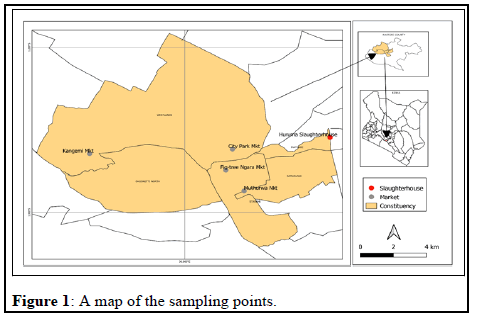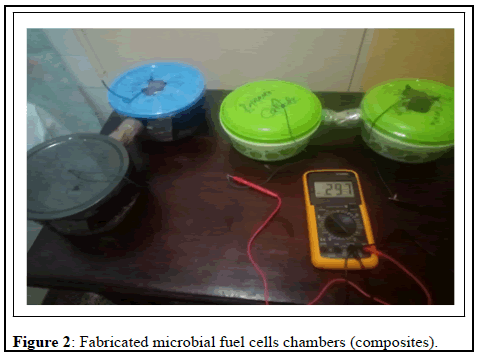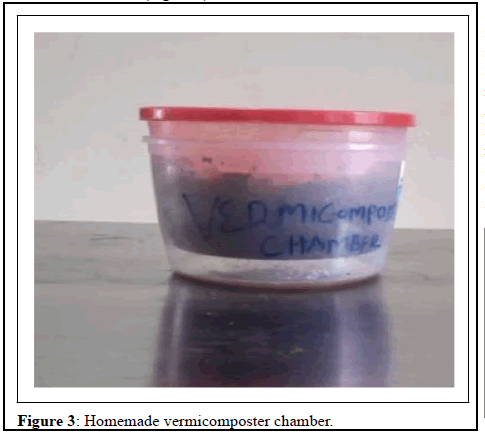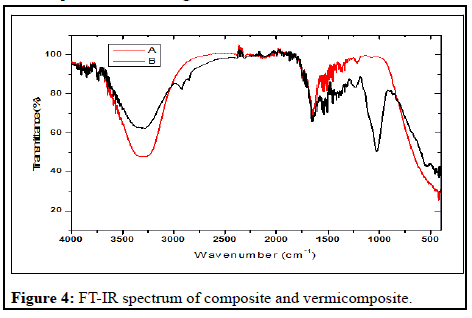Biotransformation of Biodegraded Organic Waste from a Batch Mode Microbial Fuel Cell to Organic Fertilizer
Received: 08-Oct-2021 / Accepted Date: 22-Oct-2021 / Published Date: 29-Oct-2021
Abstract
Organic solid waste poses a significant environmental threat as the globe tries to keep up with its rapid output. Composting and vermicomposting are two examples of biological waste treatment technologies typically recognized as environmentally friendly and long-term solutions for managing organic waste. This study aims to determine whether composting and vermicomposting are viable methods for recovering nutrients from organic waste and restoring them to the environment. The influences of these procedures on the environment, as well as their economic potential, were investigated. This research demonstrates that composting and vermicomposting can decompose many organic wastes, allowing them to be widely adopted. Greenhouse gases were emitting throughout the composting and vermicomposting processes, according to the current study. However, intermittent aeration, bulking agents, and a greater abundance of earthworms, on the other hand, may help to minimize greenhouse gas emissions. Economic evaluations of composting and vermicomposting technologies demonstrate that these methods are generally viable, except for a few circumstances. The variances are attributable to the vast range in market value for organic fertilizer, as well as differences in cost for the composing or vermicomposting system, both of which could affect the system's economic feasibility. If the value of organic fertilizers rises and carbon credits for nutrient recycling become accessible, this will benefit the financial feasibility.
Keywords: Biodegradation; Earthworm; Fruit waste; Organic fertilizer; Vermicompost
Introduction
Cities worldwide generate over 1.3 billion metric tons of solid trash per year, nearly doubling the amount produced a decade earlier [1]. Solid garbage generation is to quadruple once more by 2025 [2]. The rapid expansion in the global population and rate of urbanization is linked to the annual increase in solid waste creation. As a country's standard of living and affluence rises, so does its consumption of products and services, resulting in more solid waste per capita [1]. In lower to middle-income countries, waste generation rates are expected to increase by 38%-67% by 2025 compared to current levels. Waste generation rates have more or less stabilized in higher-income nations over the last decade [3] because their entire population is primarily urban [1]. Although higher-income countries generate more solid waste, they recycle more and have the means to implement new wastetreatment technology, reducing trash generation and disposal [4].
On the other hand, developing countries typically lack technical and financial capabilities, resulting in scarce resources for safe final waste disposal. The inability of underdeveloped countries to handle organic waste due to a lack of resources is a significant issue that must be addressed [3]. The resource flow in a zero-waste system is circular, with resources conserved and recovered for reuse in similar or other processes. In other words, trash from one business could be repurposed or turned into high-value inputs for different industries or functions [5]. Both landfilling and incineration with slight energy recovery fall short of the 'zero waste' concept's intents and goals [6]. Open dumping and landfilling are still the most common solid waste disposal methods in low- and middle-income nations. However, a cost-benefit study of composting versus landfilling finds that the former is the more appealing alternative due to fewer environmental and societal costs [3]. Reusing garbage could also save money on management costs by lowering organic waste sent to landfills [7]. Compared to other disposal procedures, efficient treatment and recycling of value-added goods like compost to agricultural land has proven to have reduced global warming potential [8]. According to life cycle assessment studies, composting has fewer environmental implications than alternative organic waste disposal methods like landfilling and incineration [9].
In conclusion, composting and vermicomposting may be the most promising solution for organic waste management, particularly in lowincome nations, because they are less expensive and have a more negligible environmental impact. Composting and vermicomposting processes produce organic fertilizer from trash, demonstrating that they fit the cleaner production paradigm. Furthermore, the global understanding of the need to recover valuable organic materials and return them to the soil is the driving force behind the development of composting and vermicomposting (or other reuse techniques) in organic solid waste management.
Epigeic, endogeic, and anecic earthworms are the three different types of earthworms. Epigeic earthworms are the most suitable for the vermicomposting process because they reside in organic horizons and feed predominantly on decaying organic materials. On the other hand, endogeic earthworms feed on subsurface soil and live beneath the ground surface, whereas anecic earthworms prefer to feed on earth and live deep within it [10]. The most efficient biodegrades of organic waste and releasers of nutrients into the soil are epigeic species. Furthermore, a recent study found that the epigeic earthworm's surface-dwelling way of life protected them against pesticide exposure [11]. Eisenia fetida and Eisenia andrei are the most often employed epigeic earthworms in vermicomposting because they are peregrine, have a globe range, are hardy, and have a wide temperature tolerance [12]. This research looked into the feasibility of employing composting and vermicomposting to bio-transform organic waste (fruit waste) bio-degraded in an MFC using microorganisms into an organic fertilizer as a long-term waste management approach.
Biotransformation description
Composting and vermicomposting process: Composting is the biological degradation of organic waste, occurring in either aerobic [13] or anaerobic [14] environments, with the former being more prevalent. Organic waste is devoured as a substrate by aerobic thermophilic and mesophilic microbes, which then convert it to mineralized compounds such as CO2, H2O, NH4+ or stabilized organic matters [15]. The resulting compost is a complex, stable, humus-rich combination that can improve soil physical qualities [16]. Temperature, initial C/N ratio, aeration, porosity, moisture content, and pH are all factors that influence the composting process [17]. These factors are monitored and controlled during the composting process to provide an ideal environment for microorganisms to decompose organic waste [18]. Composting is a biological degradation of organic waste that results in vermicompost, a stabilized organic fertilizer. Vermicomposting uses interactions between earthworms and microorganisms to biodegrade organic waste more quickly, unlike composting [19]. By fragmenting and conditioning the substrate, earthworms are the primary drivers in the breakdown of organic waste. Earthworms do this by increasing the surface area of organic waste exposed to microbes. As a result, microbial activity and the decomposition of solid waste are improved. Vermicomposting produces vermicompost or earthworm cast with a low carbon-tonitrogen ratio, excellent porosity, water-holding capacity, and readily available nutrients [20]. The efficiency of the vermicomposting process is controlled by various elements, including the initial C/N ratio, moisture content, pH, and the composition of the organic waste, just like composting. In contrast to composting process, all parameters influencing vermicomposting are intrinsically tied to the earthworm species used in the biodegradation process.
Materials and Methods
Sampling site
Waste samples used in this study were: Rumen fluid from a slaughterhouse in Huruma (1º 15'16. 4" S 36º 52'42.4"E), the fruit wastes from Fig-tree Ngara market (1º16'27.9" S 36º 49'20.6" E), Muthurwa market (1º 17'13.3"S 36º 49'56.2"E), Kangemi market (1º 15'52.0"S 36º 44'54.4"E), and City park market (1º 15'42.1"S 36º 49'33.6"E) all from Nairobi City County. The sampling sites are shown in Figure 1.
Sample collection
Fruit wastes and rumen fluid: Fruit and vegetable trash samples were gathered from rubbish piles in Nairobi city markets at random intervals. The wastes were separated and stored at room temperature in a laboratory for three days to allow natural decomposition. The scraps were then mixed separately and kept refrigerated until they were ready to use. Rumen fluid samples were collected from the Huruma slaughterhouse in 5-liter cooler box containers and transported to the Microbiology laboratory for bacteriological studies at the University of Nairobi's College of Agriculture and Veterinary Sciences.
Earthworms: The earthworms were sampled along the Nairobi river bank in Nairobi County by drilling a short trench, excavating the soil onto a sheet, and manually sorting for earthworms. Earthworms were collected and stored in a jar with damp soil (mud) and a nylon and rubber band to fasten the lid. Before preparing the Vermicast, all earthworms were fed into the Vermicomposting chamber within 24 hours, preserved, and allowed to rest for 45 days.
Experimental procedure
Composting: Market fruit wastes such as mango, banana, tomato, watermelon, and avocado were chopped and homogenized individually in a blender, then 100 g of each sample was placed in separate anodic chambers of the Microbial Fuel Cell. A 100 g mixture of all fruits samples was homogenized in a blender and supplied into a separate clean anodic chamber. 250 mL rumen fluid from the Huruma slaughterhouse was placed into the anodic cell to introduce the bacteria, while 500 mL distilled water was introduced into the cathodic cell. The current and voltage were measured every day for 30 days using a digital multi-meter. Following that, the MFCs' biodegraded waste was prepared for additional 45 days of Vermicomposting. Pathogen reduction and sanitization of organic waste are similarly dependent on the high temperature obtained in this phase. The germs in the organic waste were killed by temperatures exceeding 55ºC (Figure 2).
Vermicomposting: Bulking agents or additives were employed to make the organic waste more palatable for the earthworms during the vermicomposting process. Because it is the most accessible animal waste for developing earthworms, animal manure was employed as an amendment in the vermicomposting process. As a result, after 30 days of biodegradation of the fruit waste utilizing microorganisms in an MFC, the biodegraded waste was placed in a prepared single chamber vermicomposter and epigeic varieties of earthworms fed on them for 45 days in the composting stage. The obtained vermicasts were then sieved to remove any remaining particles. After oven drying at 105ºC to a consistent weight, a portion of the vermicasts was weighed and then thoroughly washed with water to remove the minute soil particles present in the vermicasts. The dirt was separated and oven-dried (at 105ºC) to a consistent weight [21]. The oven-dried ground was quantitatively transferred to a silica crucible and fired at 550ºC in a muffle furnace. The amount of organic matter adhered to the soil particles were calculated using the weight loss on ignition [22]. As a result, we determined the mass percent of soil particles in the vermicasts each time. The entire mass of vermicasts retrieved was deducted from this fraction. As a result, the seroconversion results reported here only apply to feed conversion to vermicasts and do not include entrained soil (Figure 3).
FT-IR analysis: A Shimadzu Fourier Transform Infrared Spectrophotometer, Model IRAfinity-1S, investigated the functional groups in the composite and vermicompost materials. The method employed was Attenuated Total Reflectance (ATR) combined with FTIR, which uses the total internal reflection property to produce an evanescent wave. Without any additional preparation, ATR allows samples to be analyzed in their solid or liquid condition. The spectral resolution was set at 4 cm-1 and the scanning range from 400 cm-1 to 4000 cm-1 [23].
Results And Discussion
FT-IR Spectra of biodegraded fruit waste from Microbial Fuel Cells (composite-B) and Vermicast from (vermicompost-A) samples synthesized using ATR as depicted in Figure 4 below. From the figure, the spectra B resulted in peaks at 1000 cm, 1625 cm, 2750 cm-1, 2875 cm-1 , 3375 cm and spectra A resulted in peaks at 1625 cm-1 and 3400 cm-1 were observed and have been reported to be as a result of C-H bending/C-O stretching, C=C/C=O /C-O stretching, HC= O stretching, C-H stretching, O-H stretching and C=C/C=O/C-O stretching frequencies respectively (Figure 4).
FT-IR spectrum with background correction
Figure 4 is an FT-IR Spectrum demonstrating the functional groups in the two spectrums. A peak intensity at spectra-A indicates an increase in the amount (per unit volume) of the active group associated with the molecular bond. it was related to Acetic Acid of molecular weight 60.05 g/mol. Spectra-b was associated with Butyric Acid with molecular weight 88.11 g/mol. With a suggestion that the Earthworms fragmented and degraded the waste further, reducing the number of carbon atoms. A previous study [24] observed that the band appearing at 3407.6 cm-1, 3435.5 cm-1 and 1545.0 cm-1 was assigned to O-H stretching of water and C=C stretching vibration respectively; this is similar to the current study (Tables 1-3).
| Chemical properties of composite | |
|---|---|
| PH | 8.830.05 |
| EC | 0.814 dS/m |
| (g/kg) OM | 179.2 ± 1.0 |
| C/N Ratio | 7.1 ± 0.2 |
| Micronutrients of composite | g/kg |
| N | 32.4 ± 1.4 |
| P | 8.9 ± 0.1 |
| K | 0.003 ± 0.00004 |
| Ca | 1.8 ± 0.22 |
| Mg | 1.3 ± 0.02 |
| Zn | ND |
| Mn | ND |
| Fe | 4.85 ± 0.08 |
| Cu | 0.17 ± 0.01 |
Table 1: Chemical properties of composite waste.
| Chemical properties of manure | |
|---|---|
| PH | 8.18 ± 0.01 |
| EC | 0.501 dS/m |
| (g/kg) OM | 120.1 ± 0.3 |
| C/N Ratio | 8.6 ± 0.06 |
| Micronutrients of animal manure | g/kg |
| N | 58.6 ± 1.3 |
| P | 2.1 ± 0.01 |
| K | 9.5 ± 0.05 |
| Ca | 25.4 ± 2.1 |
| Mg | 6.7 ± 0.16 |
| Zn | ND |
| Mn | 8.84 ± 0.13 |
| Fe | 5.48 ± 0.12 |
| Cu | 0.43 ± 0.01 |
Table 2: Chemical properties of manure.
| Chemical properties of vermicast | |
|---|---|
| PH | 9.84 ± 0.05 |
| EC | 0.552 dS/m |
| (g/kg) OM | 335.2 ± 1.8 |
| C/N Ratio | 6.43 ± 0.2 |
| Micronutrients of vermicast | g/kg |
| N | 87 ± 3.8 |
| P | 7.6 ± 0.07 |
| K | 18 ± 0.23 |
| Ca | 97.4 ± 11.9 |
| Mg | 7.1 ± 0.11 |
| Zn | 0.013 ± 0.0001 |
| Mn | 16.74 ± 0.22 |
| Fe | 6.61 ± 0.11 |
| Cu | 0. 62 ± 0.03 |
Table 3: Chemical properties of vermicast.
The bio-graded waste of fruit indicated a Total Organic carbon of 20.825 mg/ml and animalmanure gave TOC of 131.77 mg/ml, while Vermicast was 384.1 mg/ml
In summary, both composting and vermicomposting are considered suitable methods for managing organic waste because they not only help to solve the problem of waste disposal but also produce helpful bio-amendment agents (organic fertilizer). However, vermicomposting is superior to composting because it has a higher organic matter decomposition and nutrient content. Furthermore, vermicomposting produces increased hormones and enzymes, which may drive plant development while warding off diseases. However, current research suggests that a successful mix of the two may be a viable option for producing a higher-quality organic fertilizer.
Conclusion
Composting and vermicomposting technology have been shown in the literature to break down a variety of organic solid wastes and turn them into value-added products (s). Vermicompost is an excellent organic fertilizer to improve the physical, chemical, and biological qualities of soil. The concept behind combining the two procedures is that composting allows sanitization and elimination of hazardous substances from solid waste. In contrast, vermicomposting reduces particle size and increases nutrients available to the plant quickly. The net economics of applied vermicompost and inorganic fertilizers must be compared to determine whether such organic amendments are costeffective for farmers and, if not, how these amendments can be made more cost-effective in the future so that farmers in both the developed and developing worlds can benefit without hesitation.
Acknowledgments
The authors are thankful to the Supervisors in the Chemistry Department, Faculty of Science and Technology, the University of Nairobi for their constant encouragement and support in conducting this study.
Conflicts of Interest
The authors declare no conflicts of interest regarding the publication of this paper.
References
- Hoornweg D, Bhada-Tata P (2012) What a waste: A Global Review of Solid Waste Management.
- Hoornweg D, Bhada-Tata P, Kennedy C (2013) Waste production must peak this century. Nature 502: 615-617.
- Towards a Green Economy (2011) : Pathways to Sustainable Development and Poverty Eradication. UNEP.
- Sim EYS, Wu TY (2010) The potential reuse of biodegradable municipal solid wastes (MSW) as feedstocks in vermicomposting. J Sci Food Agric 90(13): 2153-2162.
- Curran T, Williams ID (2012) A zero-waste vision for industrial networks in Europe. J Hazard Mater 207-208: 3-7.
- Scharff H (2014) Landfill reduction experience in The Netherlands. Waste Manag 34(11): 2218-2224.
- Cabanillas C, Stobbia D, Ledesma A (2013) Production and income of basil in and out of season with vermicomposts from rabbit manure and bovine ruminal contents alternatives to urea. J Clean Prod 47: 77-84.
- Samolada MC, Zabaniotou AA (2014) Comparative assessment of municipal sewage sludge incineration, gasification and pyrolysis for sustainable sludge-to-energy management in Greece. Waste Manag 34(2): 411-420.
- Saer A, Lansing S, Davitt NH, Graves RE (2013) Life cycle assessment of a food waste composting system: environmental impact hotspots. J Clean Prod 52: 234-244.
- Yadav A, Garg VK (2011) Industrial wastes and sludges management by vermicomposting. Rev Environ Sci Biotechnol 10: 243-276.
- Suthar S (2014) Toxicity of methyl parathion on growth and reproduction of three ecologically different tropical earthworms. Int J Environ Sci Technol 11: 191-198.
- Makan A, Assobhei O, Mountadar M (2014) Initial air pressure influence on in-vessel composting for the biodegradable fraction of municipal solid waste in Morocco. Int J Environ Sci Technol 11: 53-58.
- Minale M, Worku T Anaerobic co-digestion of sanitary wastewater and kitchen solid waste for biogas and fertilizer production under ambient temperature: waste generated from condominium house. Int J Environ Sci Technol 11: 509-516.
- Qian X, Shen G, Wang Z, Guo C, Liu Y et al. (2014) Co-composting of livestock manure with rice straw: characterization and establishment of the maturity evaluation system. Waste Manag 34(2): 530-535.
- Watteau F, Villemin G (2011) Characterization of organic matter microstructure dynamics during co-composting of sewage sludge, barks, and green waste. Bioresour Technol 102: 9313-9317.
- Shafawati SN, Siddiquee S Composting of oil palm fibers and Trichoderma spp. as the biological control agent: a review. Int Biodeterior Biodegrad 85: 243-253.
- López-González JA, Suárez-Estrella F, Vargas-GarcÃa MC, López MJ, Jurado MM, et al. (2015) Dynamics of bacterial microbiota during lignocellulosic waste composting: studies upon its structure, functionality, and biodiversity. Bioresour Technol 175: 405-416.
- Sim EYS, Wu TY (2010) The potential reuse of biodegradable municipal solid wastes (MSW) as feedstocks in vermicomposting. J Sci Food Agric 90: 2153-2162.
- Lim SL, Wu TY, Lim PN, Shak KPY (2015) The use of vermicompost in organic farming: overview, effects on soil and economics. J Sci Food Agric 95: 1143-1156.
- Gajalakshmi S, Ramasamy EV, Abbasi SA (2001) Potential of two epigeic and two anesic earthworm species in vermicomposting water hyacinth. Bioresour Techno 76: 177-181.
- Allen SF, Grimshaw HM, Rowland AP (1986) Chemical analysis. In: Moore, P.D., Chapman, S.B. (Eds.), Methods in Plant Ecology, seconded. Blackwell Scientific Publication 284-341.
- Wang Q, Fan X, Gao W, Chen J (2006) Characterization of bio-sourced cotton fabrics using FT-IR ATR spectroscopy and microscopy techniques. Carbohydrate Research 341(12): 2170-2175.
- Jin X, Liu Y, Tan J, Owen G, Chen Z (2018) Removal of Cr(vi) from aqueous solutions via reduction and absorption by green synthesized iron nanoparticles. J clean prod 176: 929-936.
Citation: Imwene KO,M bui DN , Kinyua AP, Mbugua JK, Ahenda S, et al.(2021) Biotransformation of Biodegraded Organic Waste from a Batch Mode Microbial Fuel Cell to Organic Fertilizer. J Bioremediat Biodegrad 12:011.
Copyright: © 2021 Imwene KO, et al. This is an open-access article distributed under the terms of the Creative Commons Attribution License, which permits unrestricted use, distribution, and reproduction in any medium, provided the original author and source are credited.
Share This Article
Recommended Journals
Open Access Journals
Article Usage
- Total views: 2778
- [From(publication date): 0-2021 - Apr 01, 2025]
- Breakdown by view type
- HTML page views: 2184
- PDF downloads: 594




